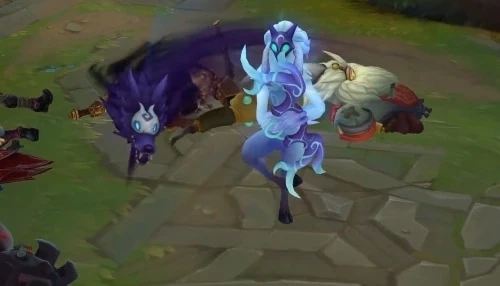Although versatile, Kindred’s gameplay is difficult to grasp initially for most players. The best way to improve how to pilot them is through knowing the basics of a proper predator’s tactics. Here is everything you need to know about playing the Eternal Hunters.
Kindred’s core concept
Kindred is a marksman dedicated to the jungle role. However, they can also be found on the lanes and the middle lane is where they are most prominent. They are still best seen in the jungle as the lanes tend to be too spacious for their kit that relies on hiding places.
Unlike a typical League of Legends marksman, Kindred is one of the best for rotating around the map alone rather than relying on an ally. The only time that they need assistance is when targeting a champion marked by their passive ability, Mark of the Kindred.
As Kindred, you have to plan how you play on collecting marks. Wolf automatically marks jungle camps and it is up to you whether you should take it. Enemies can see these marks and they know letting you take it will make you stronger so it will be dangerous to get them all the time.
However, this mechanic makes the early game more intense than in games without Kindred. Both sides are forced to react to marks appearing and decide whether to be invasive or defensive. This draws everyone out into a risky position that a good Kindred player can exploit for their team’s advantage.
Ideal runes and item builds
Kindred can prioritise either critical hit rate or on-hit effects thanks to their efficient scaling with attack speed. They benefit greatly from the precision and domination rune trees with specific preference for Conqueror, Legend: Alacrity, Sudden Impact, and Relentless Hunter.
For a more aggressive playstyle, opt for Hail of Blades and Taste of Blood supplemented by Waterwalking from the Sorcery runes. The rest of the rune slots should cater to Kindred’s health like Last Stand and Triumph from Precision or Ravenous Hunter from Domination.
Starter items include Emberknife, Refillable Potion, and Stealth Ward. Take the Noonquiver as early as possible then Boots. As of season 12, Kindred players are encouraged to rush the Kraken Slayer in the first 20 minutes followed by Berserk Greaves then The Collector. These are the core items. The remaining three can be whichever scales your attack speed and damage.
If you are in the middle lane, opt for an Essence Reaver before the Kraken Slayer then remove The Collector. Your fourth item is best be Rapid Fire Cannon for the extra range but you can opt for the Statik Shiv if you need more power in teamfights.
Decide whether to take Infinity Edge or Guardian Angel depending on what you need. Opt for the latter first if you have trouble surviving teamfights or go for Infinity Edge if you have no problem kiting. The Lord Dominik’s Regards is the best situational item against two or more tanks in the opponent’s team. Otherwise, stick with Guardian Angel.
Skill level priority
Always take Wolf’s Frenzy (W) first followed by Dance of Arrows (Q) then Mounting Dread (E). Afterwards, maximise your Q as fast as possible unless Lamb’s Respite is available for level up. Completing Q should take priority, but you can invest on W at level 8 so you have better sustain damage in the mid game.
Once Q is maxed out, prioritise W until level 11 where you should level up R. E should be your last priority for levelling up regardless of whether you are a lane carry or a jungler because Q and E are your main source of damage. E only helps in situations where the opponent is too tanky to take down quickly.
Standard jungle clear path and gank priority
Kindred can gank early but they are best suited for clearing jungle camps first until they take the first scuttle crab. There are two paths and both will have you take 6 camps in total and your goal is to reach the first marked camp as soon as possible. Only do this within your jungle area unless you have defeated the enemy jungle along the way and your allies can preoccupy their rivals in the lane.
The first path starts with the red buff into raptors, then wolves. Afterwards, take the blue buff, kill Gromp, and take the northside scuttle crab. The second path starts with blue buff, then Gromp into wolves, then cross over to the red buff. Take the raptors afterwards then take the scuttle crab on the southside river. Gank the closest side lanes or the mid if the opponents are over extending, otherwise, recall to base.
Playing Kindred as a lane carry
Kindred needs to roam everywhere on the map to collect marks which is why the middle lane is the perfect spot for them. However, some prefer ignoring the marks in the early game and compensate by scaling just like other marksmen through minion last hits and bounties. Kindred’s W is amazing for poking opponents thanks to its wide area of effect. The Q serves a more defensive function against ganks or an efficient means to last-hit minions.
Best time to chase after marks
The best time to chase after marks for a jungle Kindred is always immediately once they are up. Always secure a 1v1 scenario either by pressuring the other lanes or hunting roaming targets. If the opponents prefer grouping up against you, then it’s better to always disengage until the mark automatically moves to an easier target.
Midlane Kindred must cooperate with their side-lanes and jungle on how to approach marked prey. Collecting runes wouldn’t be easy otherwise as Kindred is not capable of surviving a 1v2 encounter like any League of Legends marksman. Duo lane Kindreds can hold off on collecting marks until teamfights are being initiated in the mid game.
0


